
NACA test pilot on P-80 during the late 40s. (NACA) |

Scott Carpenter during weightless training on F-100 during the early 60s. (LIFE) |

Mercury Friendship 7's cockpit in 1962. (NASA) |

Joe Walker on L.E.M. flight simulator. (NASA) |

Astronaut Tom Stafford inside the Gemini IX capsule (NASA) |

X-15 at Edwards AFB during the middle of 60s (NASA) |
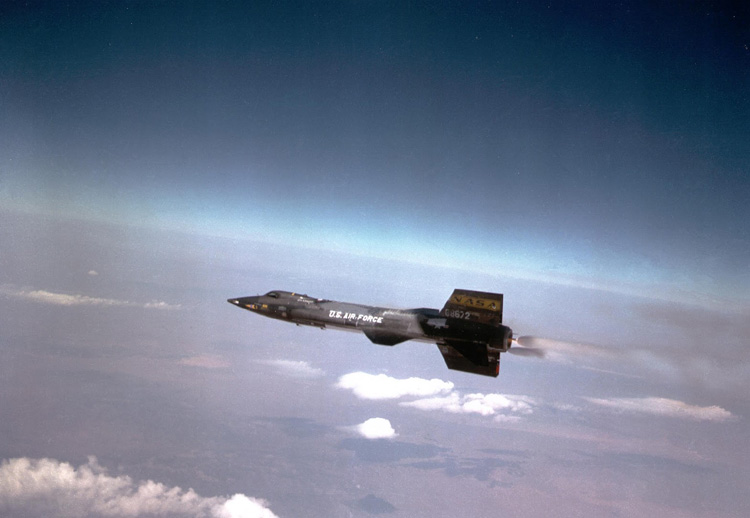
X-15 during a flight over Edwards AFB during the middle of 60s (NASA) |

Research rocket aircraft X-15A-2 attached under the right wing of a NB-52B. (NASA) |
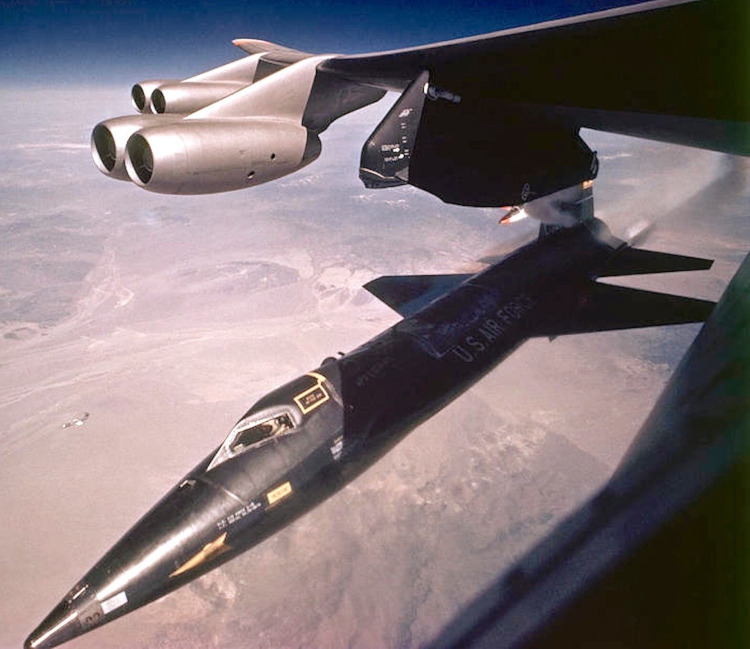
X-15 just dropped from the NB-52B during the middle of 60s (NASA) |

Research rocket aircraft X-15 attached under the right wing of a NB-52A escorted by an USAF F-104A. (NASA) |

Astronaut Pete Conrad clims out of Gemini 5 Command Module after the splash down in 1965 (NASA) |

Astronauts Neil Armstrong and David Scott of Gemini 8 inside the Command Module after the splash down in 1966 (NASA) |

M2-F2 lifting body and NASA F-104A at Edwards AFB in 1966 (NASA) |

Apollo 8 Command Module lifted on board of USS Yorktown in 1968 (NASA) |

NASA F106B in the Lewis Research Center in 1969 (NASA) |

NASA astronaut Neil Armostrong near the L.E.M. flight simulator in 1969 (NASA) |

Apollo 16 LEM and the Lunar Rovering Vehicle on Moon surface in 1972 (NASA) |

Apollo 16 Commander John Young on Moon surface in 1972 (NASA) |

Apollo 17 Command Module in Moon orbit, December 1972 (NASA) |

Cockpit of the NASA Gulfstream II used as Shuttle Training Aircraft. (NASA) |

Flight Deck of Shuttle Enterprise during the glide flight test. (NASA) |
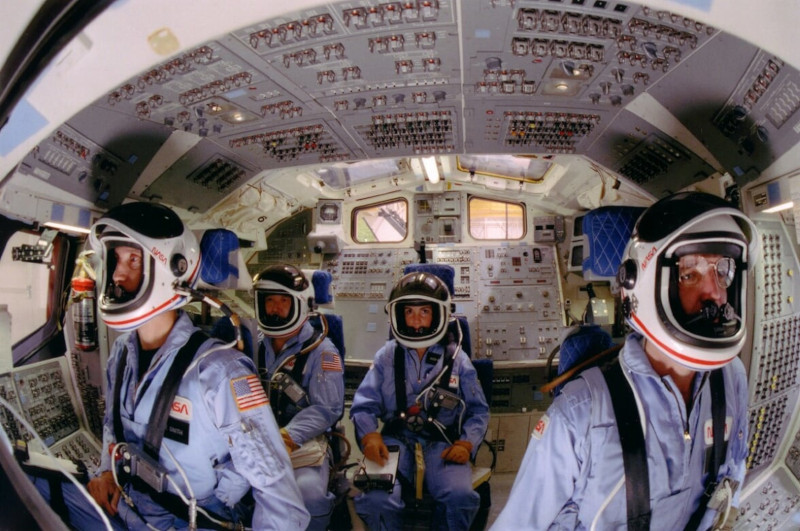
Crew inside Flight Deck of Space Shuttle during training with not pressurized flight equipment used before the Challenger incident. (NASA) |
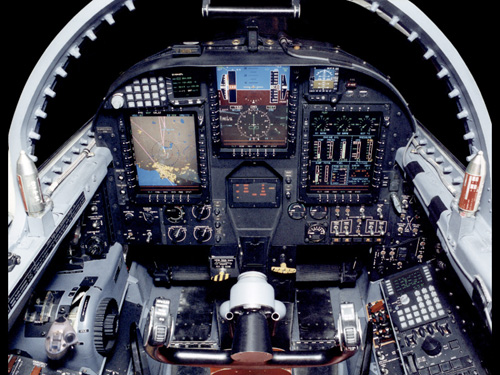
NASA U-2S high altitude research aircraft cockpit. (NASA) |

NASA test pilot and former astronaut Gordon Fullerton on F-18 Hornet. (NASA) |

NASA Space Shuttle Commander Rick Husband. He tragically died during the STS-107 Columbia incident. (NASA) |

NASA T-38N. (www.steehouwer.com) |
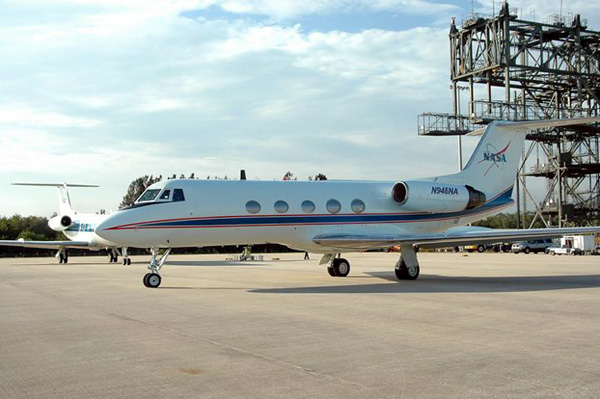
NASA Gulfstream II used as Shuttle Training Aircraft (NASA) |

During the Shuttle program, NASA astronauts flying T-38s practice the famously steep Space Shuttle "Flying Brick" approach.
During the first stage, the Shuttle lines up with the runway at 10,000ft, 6.9 NM from the runway, flying a 17 to 19 degrees glide slope to a point 0.89 NM short of the runway. At 3000ft the speed brake is set to a calculated position to allow touchdown at a point 2500ft down the runway.
The second stage starts at around 1750ft AGL. At this altitude the Shuttle pre-flares, changing its glide slope from the steep 17 to 19 degrees dive to a shallow 1.5 degrees glide slope all the way to touchdown. This shallower approach bleeds off the excess speed used during the initial approach and allows the Shuttle to land at a nominal touch down speed of 195 to 205kt.
(NASA) |

Commander Steven Lindsey on Gulfstream II STA. The left side of the cockpit is modified to represent the instrumentation on Shuttle Orbiter. (NASA) |

Space Shuttle Discovery of STS-121 is approaching the Internatonal Space Station. (NASA) |

NASA T-38N at Kennedy Space Center Shuttle Landing Facility. (NASA) |

NASA T-38N at Houston Ellington Field. (NASA) |

NASA T-38N at Kennedy Space Center Shuttle Landing Facility. (NASA) |

NASA T-38N at Kennedy Space Center flying over Space Shuttle launch PAD in 2009. (NASA) |

NASA T-38N and STA at Kennedy Space Center flying over Space Shuttle launch PAD in 2009. (NASA) |

ESA Mission Specialist Roberto Vittori (Italy) on a NASA T-38N. (NASA) |

NASA T-38N with crew of STS-134 at Kennedy Space Center. (NASA) |

International Space Station pictures taken by STS 133 crew in 2011. (NASA) |

An S-3B Viking in the colors of NASA in Glenn Research Center 2008. (NASA) |

NASA flight photographer in the rear cockpit of a WB-57F research aircraft. (NASA) |

SpaceX Crew Dragon Demo-1 unmanned mission performing the automated docking with the International Space Station in 2019. (NASA) |

Boeing Starliner during the first manned mission docked to the ISS during the 2024. (NASA) |